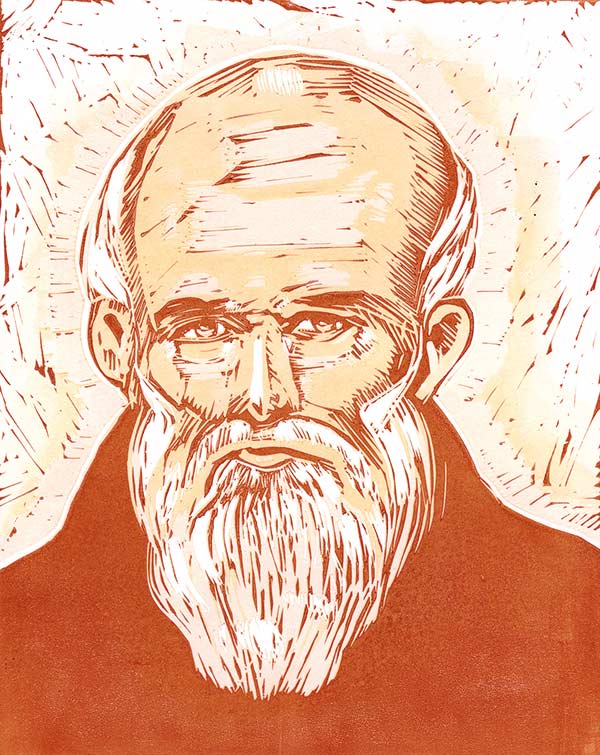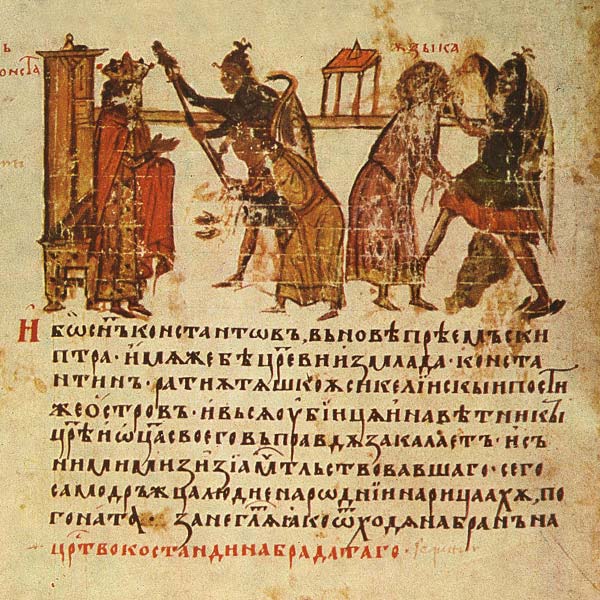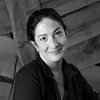Subtotal: $
Checkout
A World Full of Signs
Maximus the Confessor saw the natural world as charged with symbolic meaning.
By Susannah Black Roberts
May 27, 2024
Available languages: Deutsch
Next Article:
In AD 653 Byzantine Emperor Constans II ordered the arrest of Pope Martin I, and with him, an elderly monk named Maximus. The pope had been elected four years earlier against the emperor’s will, and had called a council to deal with the most pressing theological issue of the day: Did Christ possess a human will as well as a divine one? The council said yes; the emperor disagreed. Put on trial, the pope and Maximus both refused to recant. Sent into exile, Martin died within a few years, but Maximus lived on, until 662, when he was brought to trial once again. Again, he refused to recant. He was tortured, his tongue cut out and his right hand cut off, so that he could no longer speak or write. Cast into the fortress of Schemarum, in what is now Georgia, he died soon afterward.
What had he written with that hand? What had he spoken with that tongue? Who was this man?
According to tradition, Maximus was born to a noble family in Constantinople and became first secretary to Emperor Heraclius, grandfather of the emperor who persecuted him. He left imperial service to become a monk, and eventually abbot, at a monastery in Chrysopolis.

Tom Callos, Maximus the Confessor, linocut reduction print, 2024. Used by permission.
His theological vision was rich and broad. Of particular interest here is his idea of nature as a book. As a Christian, Maximus was an heir to the traditions of the Hebrews, but he was also addressing the questions of Greek philosophers such as Thales and Aristotle, who had tried to explain the world through natural causes. Natural phenomena, Maximus agreed, were not divine in themselves, nor caused by gods, and could be investigated on their own terms. But why, he asked, are we able to understand ourselves and the natural world in the first place? Only because that world was made, said Maximus, by the God who created us in his image, capable of comprehending the universe or at least able to perceive its patterns – that is, able to read the book of nature.
For Maximus, just as for Thales and Aristotle, nature is emptied of its divinities. It is no longer a self-enclosed system of petty gods of springs and trees and ocean and earth and sky. But he also didn’t view nature as a self-enclosed system of cause and effect, as Thales and his fellows (and their materialist heirs) would posit. Nature is not just something to which we can apply science. His reading of nature was not an attempt to stretch her on the rack and make her give up her secrets.
Rather, when natural phenomena cease to be gods, they become something better: signs. Nature is not self-enclosed at all. It is not self-explanatory, but it does explain. It points, very precisely, beyond itself, to the one who made it – who made all natural phenomena and any supernatural ones.

Constans II, left, having Maximus beaten, right, for his Christological views. Miniature from the twelfth-century chronicle of Contantine Manasses. Image from Wikimedia Commons (public domain).
The apostle Paul says of the wise, “For what can be known about God is plain to them, because God has shown it to them. For his invisible attributes, namely, his eternal power and divine nature, have been clearly perceived, ever since the creation of the world, in the things that have been made” (Rom. 1:19–20). Expanding on this, Maximus says natural phenomena are signs pointing toward the truth behind nature: Christ the Logos, who “wills always and in all things to actualize the mystery of his embodiment” (Ambigua 7.22).
But that’s not all. This God, who made man in his image and capable of reading his signs, does something even more shocking. He plunges fully into nature, into the womb of a Jewish girl, taking on human nature – not by any half-measures, but fully. Fully God and fully man. And then he dies, and does not stay dead. By doing this, he makes possible the final step: he brings us humans up with him into the life of God. Eastern Orthodoxy calls this theosis, coming into union with God.
For Maximus, this possibility is shattering in its implications. Adam was given care over the earth: when he fell, the cosmos fell too, becoming “subject to decay” (Rom. 8:20–22). Christ reverses this. He is not only the “divine light” that illuminates the book, scriptural and natural; he also reveals our vocation in this world. Maximus reasons from the Incarnation to our vocation as human beings, which is to mediate and unite all the “divisions of nature” we experience, through rational understanding and loving action. So, for Maximus, our theosis is part of the Word’s ongoing incarnation:
Of these good things [in Christ], the modes of the virtues and the inner principles of what can be known by nature have been established as figures and foreshadowings, through which God always willingly becomes man in those who are worthy.
This could be taken in an unorthodox way, as suggesting that any of us could be Christ. Maximus, always orthodox, is careful to rule out such interpretations. Rather, in the New Adam, Jesus, humans are restored, drawn up into the life of God: and the whole cosmos, the whole of the natural world, is drawn up after them. It is natural for us to be supernatural, in other words. The human vocation is to extend the incarnation into the cosmos. We do this in every instance of cooperation with grace. Every act of perceiving the good, of understanding, of piety, of love continues Christ’s incarnation in all things. Here Maximus is merely confirming scripture, which states plainly:
Do not lie to one another, seeing that you have put off the old self with its practices and have put on the new self, which is being renewed in knowledge after the image of its creator. Here there is not Greek and Jew, circumcised and uncircumcised, barbarian, Scythian, slave, free; but Christ is all, and in all. (Col. 3:9–11)
Maximus is precise about these things, but bold. This, says Maximus, is theosis:
the whole man pervading the whole God, and becoming everything that God is, without, however, identity in essence, and receiving the whole God instead of himself, and obtaining as a kind of prize for his ascent to God the absolutely unique God, who is the goal of the motion of things that are moved, and the firm and unmoved stability of things that are carried along to Him, and the limit (itself limitless and infinite) of every definition, order, and law, whether of mind, intellect, or nature. (Ambigua 41.5)
This, then, is the destiny of the cosmos – through us. This is what it is all pointing toward, what all those signs have been trying to tell us all along: the marriage of heaven and earth. It’s as though we, the Bride, are pulling all of it, all the snails and woods, geese and galaxies, along with us as we walk up the aisle toward the Bridegroom.
With thanks to Dr. Jordan Wood for consultation.
Already a subscriber? Sign in
Try 3 months of unlimited access. Start your FREE TRIAL today. Cancel anytime.







Rebecca Morgan
Beautiful piece. Amazing Messiah, three in one- persons God. Makes me think of the parallels in N. T. Wright’s Into the Heart of Romans and chapter 8’s essence as the real vocation of every believer to intercede (and take loving action) in the groaning of the Spirit for ourselves and for this wounded creation which will one day soon finally be the New Heavens and the New Earth where God dwells in our midst. I’m so glad to learn about Maximus- hope to learn more.
Scot Martin
This is a good, brief introduction to Maximus.
Konstantinos Sarantidis
Beautifully written. Concise, yet capturing the essence of what St Maximus brought to Christian consciousness: a cosmic vision of nature and human as modes of Christ’s continuing incarnation. A very different vision of salvation than the juridical that still prevails in much Christian thinking.